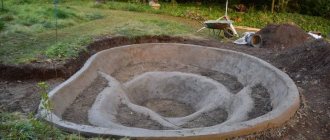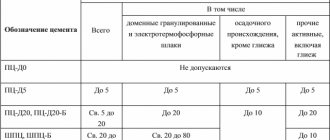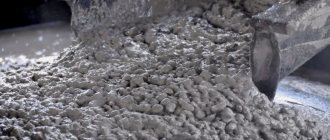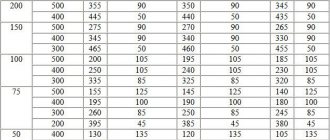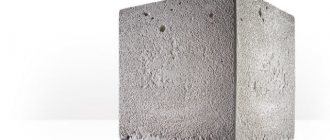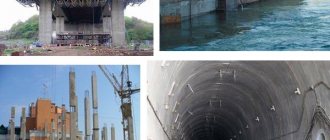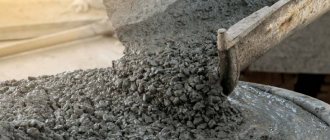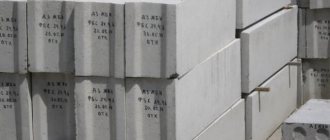Concrete is a hardened and compacted mixture of thoroughly mixed components of the following components: cement, aggregates in the form of quartz sand, crushed stone, water. To obtain the desired quality characteristics, various chemical and mineral additives can be added. This is one of the most commonly used building materials, used for preparing concrete and reinforced concrete structures, as well as performing work ranging from foundations to the roof of engineering structures.
Next, we will consider the composition, technical characteristics and scope of application of concrete M400 (B30).
Composition and proportions
The high-quality composition of class B30 concrete guarantees the use of the following components:
- high quality Portland cement, Grades M400 and M500;
- coarse filler in the form of crushed granite or gravel;
- fine-mesh filler – fine sand;
- water without impurities;
- various chemical additives that improve the properties of the finished mixture.
The ratio of components should be selected depending on the brand of Portland cement purchased.
| Cement brand | Cement | Sand | Crushed stone |
| M400 | 1 | 1,2 | 2,7 |
| M500 | 1 | ,6 | 3,2 |
Maintaining the correct proportions helps to mix a high-quality solution of the desired strength.
Advantages and disadvantages of concrete grade M400 (B30)
Brand M400 (B30) is one of the most popular in industry. The advantages of this concrete allow it to be used on various objects.
The main advantages of the M400 brand:
- High strength
- Good adhesion to reinforcement
- Minimum water permeability
- Resistance to high and low temperatures, frost
- Low abrasion
- Good susceptibility to additives, which makes it possible to improve some material characteristics
- The price-quality ratio is considered one of the most optimal among industrial brands
The disadvantages of the M400 (B30) brand are the main reason for its limited use in private construction.
The disadvantages of concrete M400 (B30) include:
- Difficulties in making the solution (this requires special equipment, high precision in the selection of components)
- The solution is difficult to work with, it hardens very quickly
- The price of the brand is too high for the budget of a private construction project
Concrete M400 (B30) is a professional grade for industrial construction. Private owners buy it only in cases where it is necessary to build a house with a height of more than two floors on a problem area or in a seismic zone. In other cases, it is not worth buying it, since you will overpay for material whose quality characteristics significantly exceed those required.
Production technology
The purchase of building materials must be carried out with constant quality control. Only fresh cement produced no earlier than three months from the date of purchase should be used. The sand must be sifted, washed and dried. This gets rid of unnecessary debris and organic particles. Gravel or granite must be rejected; the size of the fractions should not vary significantly. The water intended for mixing the mixture is filtered to eliminate the presence of impurities.
Foreign substances in the components of the solution impair its quality characteristics.
Concrete of class B30 sets quickly and the process of mixing it is best done in a factory. Automated production mixes the required dry ingredients with portioned addition of liquid. This ensures ideal homogeneity of the building mass. However, if production is located far away, it is possible to carry out mixing directly on the construction site. To do this, you need a gravity mixer with a large loading volume.
For quick pouring, it is better to use an inclined chute and be sure to walk along the surface with a vibrating plate.
Strengthening process
Chemical reactions to bind all components of the mixture begin immediately after mixing begins. The process of gaining strength in the final product occurs in waves, and over time the rate decreases:
- poured concrete gains up to 60% hardness within the first 5 days;
- the concrete mixture hardens by 70% after 10 days from the date of filling the form;
- the finished product hardens completely 28 days after concreting.
To increase the strength indicators, the concrete surface is covered with a film for a month to increase the hydration period. At temperatures exceeding 25 °C, the concrete layer should be watered with water to ensure smooth progress of strength gain.
Where is concrete M400 (B30) used?
Concrete M400 (B30) can be considered the first full-fledged industrial grade. Private owners should buy it only for objects that will bear significant loads in the future, or for buildings on sites with any problems (sloping terrain, unstable soil, high aquifer).
The main areas of use of concrete grade M400 (B30):
- Construction
- Road construction
- Concrete products
- Engineering structures
- Landscaping
In other areas, such as decorative work and furniture production, class B30 concrete is almost never used. Sometimes it is used to make load-bearing decorative columns under massive balconies, in the lobbies of hotels, concert halls, and theaters. Concrete M400 (B30) is also suitable for large fireplaces. But it can always be replaced with less expensive brands.
Application of M400 (B30) concrete in construction
Grade M400 (B30) is a popular concrete for industrial construction. The benefits of purchasing such material by private owners are questionable.
Brand M400 (B30) is used for:
- Foundations of private mansions of several floors in problem areas
- Foundations of residential high-rise buildings
- Foundations of public buildings (for example baths, cinemas, hotels)
- Load-bearing walls or colonnades
Here are some examples:
- A 3-story mansion with an attic is being built on a site with uneven terrain and high groundwater. The place is often flooded. The climate in the construction area is cold, and the soil freezes annually by 2-2.5 m. The foundation in such a place must be made deep, from a material with high frost resistance and water resistance, otherwise it will quickly collapse. In addition, the concrete must support the weight of the structure of the house itself. In such a situation, it is worth spending money and purchasing the M400 (B30) brand.
- Let's say a two- or three-story house is being built in a seismic zone where earthquakes occur. The foundation of such a building must be strong and withstand vibration. To ensure such properties of the foundation, you need to buy concrete M400 (B30).
- The company is building a twelve-story building. The soil on the site is strong - fissured rock with clay admixtures. Groundwater is located at a depth of 3.5 m. Even in the most severe frosts, soil freezing does not exceed 1.5-2 m. In this case, the M400 (B30) brand is the best option. If the site is more problematic (for example, with clay or sandy soil, high aquifer), then the M450-M500 grades are more suitable for such a building.
With some reservations, the M400 (B30) brand can be used for:
- Bases under the garage
- Solid walls and ceilings between floors
- Beams and crossbars
- Floors on the ground
- Blind areas
- Ties
- Stairs
- Drainage systems
Here are a few examples that demonstrate the feasibility of purchasing M400 concrete for the work listed above:
- Durable concrete may be needed for the foundation of a large 2-3-story garage located on the territory of a factory or shopping center. It will simultaneously contain several dozen cars and heavy equipment. Therefore, the foundation must be strong.
- Concrete M400 (B30) can be used for floors, solid walls and stairs in a multi-storey building.
- The drainage system is constantly exposed to water, so the concrete in it must be waterproof. Brand M400 should be used if the amount of waste is very large. In other situations, it is better to replace it with concrete M250-M350.
For blind areas, screeds, and ground floors, you can use leftover concrete mortar after other work or material purchased at a big discount. Sometimes factories sell cheaper batches with minor defects. They are quite suitable for pouring floor coverings or blind areas.
Application of M400 (B30) concrete in road construction
Concrete M400 (B30) is durable and resistant to abrasion. Therefore, it can be used on roads of any class. It is suitable for expressways, congested city avenues, and large highways. True, for roads with low traffic such material is not very profitable. Here the best option would be the M200-M350 brands.
M400 (B30) is suitable for:
- Single-layer road surfaces
- Top of two-layer coatings
- Production of road slabs
Also, grade M400 (B30) can be used in the lower part of two-layer coatings. But the concrete in this place does not necessarily have to have very high strength and abrasion resistance. Therefore, grades M250-M350 are often used for the bottom layer.
Let's give a couple of examples for clarity.
In a small town, the road on the main street needs to be completely rebuilt. It is planned with a single layer coating. For this it is quite possible to use M400 (B30) concrete. But if the traffic on such a road is not too intense, then grades M300-M350 can be used for its construction.
Another example is that it is planned to build a highway that will connect two regional centers. More than 10,000 vehicles, both passenger cars and heavy trucks, will pass through it per day. The coating, according to the project, is made of two layers. The best grade of concrete here is M400 (B30) for both layers. If the budget is limited, the lower part of the covering can be made of M350 concrete.
Application of M400 (B30) concrete in the production of reinforced concrete products
Concrete M400 (B30) is one of the most popular brands for concrete products. It is suitable for most products. The strength of the material fully meets the requirements for most types of products. Thanks to its high water resistance, metal frames of reinforced concrete products will be completely protected from corrosion.
Grade M400 (class B30) is used for:
- Foundation slabs for residential and industrial buildings
- Floor slabs in residential buildings and industrial enterprises
- Plates for partitions in industrial buildings
- Slabs lining airfield runways
- Poles for electrical networks and lighting fixtures
- Pressure and non-pressure pipes
- Well rings
- Tetrapods (breakwaters)
Grade M400 (B30) can be used for the production of internal lintels in residential premises, fence posts, and external reinforced concrete panels. But in these situations, the use of M300-M350 concrete will be more profitable.
Railway sleepers are also produced from M400 (B30) concrete. But such products are subject to significant stress, especially from vibration created by passing trains. Therefore, for sleepers on railway lines with heavy traffic, it is better to take more durable grades - M500-M600.
Reinforced concrete products are also used in engineering structures (in the construction of bridges, dams, overpasses). But before you decide to use M400 (B30) concrete for them, you need to correctly calculate all the loads. If they are large, it is better to use stronger brands.
Application of M400 (B30) concrete in engineering
Engineering structures are objects with complex architecture that are subject to significant loads. They often operate in unfavorable conditions. The basis of most structures is concrete. Its quality determines how long objects will last without repair, whether they will be reliable and durable.
Concrete M400 (B30) is used for engineering structures, although it is not the main one here. The requirements for many objects are so high that such rare grades as M800-M1000 are used for their construction. In this case, all operating conditions must be taken into account: high humidity, high or low temperatures, temperature changes.
Concrete M400 (B30) is suitable for:
- Main pipelines and oil pipelines
- Bank vaults
- Factory buildings
- Runways of small airfields
In other situations, preference should be given to more durable grades of concrete. There is no point in saving on materials when constructing engineering projects. Even the slightest destruction and cracks can provoke not only accidents with significant economic consequences, but also loss of life.
Conventionally, the M400 (B30) brand can also be used for:
- Bridges and overpasses
- Hydraulic structures (dams, dikes, piers)
- Power plants (mainly thermal power plants)
- Military facilities
- Small airport buildings
Concrete M400 (B30) is also used for drainage systems, wells, and wastewater storage facilities. But for such objects, the M300-M350 brands, which are cheaper, are also quite suitable.
The use of concrete M400 (B30) in landscaping
In landscaping, concrete M400 (B30) is used quite rarely.
There are only a few designs for which it makes sense to purchase this particular brand:
- For creating large pools
- For filling parking lots for heavy equipment, trucks, public transport (buses, trolleybuses)
For the pool bowl, you need concrete that does not absorb water, can withstand its pressure, and does not crack from frost. All these requirements are best met by the M400 brand (class B30). It is used to fill the bowls of outdoor public swimming pools and indoor swimming pools made according to Olympic standards.
In parking lots for large vehicles, less durable grades are also used - M250-M350. Concrete M400 (B30) is useful for open parking in areas with unfavorable climate.
Next you will find out what advantages and disadvantages the M400 (B30) concrete brand has.
Properties and characteristics
According to the requirements of GOST 7473-2010, class B30 concrete belongs to the type of heavy construction mixtures and must meet the following indicators:
- compressive strength – 392.9 kgf/cm2;
- density – 2,390 – 2470 kg/m3. This figure is influenced by the type of coarse aggregate;
- frost resistance index – F200. The finished structure is able to withstand harsh weather conditions in regions with sudden temperature changes;
- water resistance corresponds to W15, which allows the use of concrete in places where groundwater is close to the surface;
- mobility – P4.
Advantages
- High strength index, allowing the use of concrete for the construction of serious structures;
- fast setting.
Flaws
- It is difficult to make a solution with your own hands; you must have special equipment;
- high price discourages adoption in the private sector;
- requires significant consumption of cement mixture;
- delaminates quickly if mixing is stopped during transportation to the construction site.
Areas of use
In private low-rise construction, B30 concrete is used quite rarely. This is due to the following reasons:
- the strength and basic characteristics of the material are significantly higher than those required, according to building codes, for low-rise buildings and outbuildings;
- high quality material is distinguished by a high price, which increases the cost of the structure, which, in this case, makes its use impractical;
- The working mixture is distinguished by its fast setting, which does not allow its transportation over a significant distance even using concrete trucks or automobile mixers. The work is mainly carried out by small organizations or even teams of coven workers; the professional qualifications of such workers do not allow them to put the mixture into the work before it hardens.
The material, which has increased strength properties, reliability, durability, and resistance to aggressive environmental influences, is successfully used for the construction of critical engineering structures that are subject to significant loads during operation.
Main Application:
- construction of road and railway bridges, viaducts, tunnels;
- construction of dams and other hydraulic structures;
- production of reinforced concrete columns, beams, arches, crossbars, bridges and other structures characterized by high strength indicators;
- construction of bank vaults, energy, mechanical engineering, mining facilities subject to significant loads, multi-storey high-rise buildings, shopping and business centers, hotels, airports;
- laying the top layers of highway pavement in the form of monolithic concrete;
- swimming pools, water parks, sports and entertainment facilities.
Conclusion
- If it is necessary to build structures of increased strength, M400 grade concrete is used.
- Concrete mixture B30 (M400) is used specifically for creating foundations for high-rise buildings, in hydraulic engineering and in the construction of monolithic high-rise buildings.
- A high proportion of cement in the mixture and a sufficient amount of water provide the material with high plastic qualities.
- To make concrete, it is recommended to use river sand with a minimum amount of impurities, as well as granite crushed stone measuring 12...25 mm.
- The mixture hardens quickly, so molding must be done within 1.5...2.0 hours.
- The cost of 1 cubic meter is 3850...3935 rubles. at August 2022 prices.
How much B30 do you need?
According to SNiP 2.03.01-84, it is recommended to use the components in the proportions presented in table. 4. The calculation was performed in Excel.
Table 4: Preparation of concrete B30 according to SNiP 2.03.01-84
| Component | Mass fraction | Weight, kg | Density, kg/m³ | Volume, l | Number of buckets 10 l |
| Cement M400 | 1 | 400 | 1400 | 285,7 | 28,6 |
| Sand | 1,5 | 600 | 1600 | 375 | 37,5 |
| Crushed stone | 2,5 | 1000 | 1400 | 714,3 | 71,4 |
| Water | 0,5 | 200 | 1000 | 200 | 20,0 |
| Plasticizer | 0,019 | 7,6 | 1000 | 7,6 | 0,8 |
| Density | 2207,6 |
In "buckets"
In the last column of the table. 3 and 4 indicate the volume in 10 liter buckets. If you use buckets of a different capacity, you can recalculate. Read about ceramic brick and stone according to GOST 530 here.
In a concrete mixer
Household concrete mixers are manufactured with a volume of 110…150 liters. For cooking, not the entire volume is used, but no more than half.
Each batch will require a certain amount of components.
In table Table 5 presents recommendations obtained from actual practice of self-preparing concrete mixtures, corrected using a spreadsheet processor.
Table 5: Preparation of concrete mixture in a household concrete mixer with a volume of 110 and 130 l
| Component | Mass fraction | Weight, kg | Density, kg/m3 | Volume, l | Number of buckets 10 l |
| concrete mixer volume 110 l | |||||
| Cement M400 | 1 | 14 | 1400 | 10 | 1,0 |
| Sand | 1,5 | 21 | 1600 | 13,1 | 1,3 |
| Crushed stone | 2,5 | 35 | 1400 | 25 | 2,5 |
| Water | 0,5 | 7 | 1000 | 7 | 0,7 |
| Density | 77 | ||||
| Cement M500 | 1 | 14 | 1400 | 10 | 1,0 |
| Sand | 1,9 | 26,6 | 1600 | 16,6 | 1,7 |
| Crushed stone | 3 | 42 | 1400 | 30 | 3,0 |
| Water | 0,5 | 7 | 1000 | 7 | 0,7 |
| Density | 89,6 | ||||
| Concrete mixer volume 130 l | |||||
| Cement M400 | 1 | 15 | 1400 | 10,7 | 1,1 |
| Sand | 1,5 | 22,5 | 1600 | 14,1 | 1,4 |
| Crushed stone | 2,5 | 37,5 | 1400 | 26,8 | 2,7 |
| Water | 0,5 | 7,5 | 1000 | 7,5 | 0,8 |
| Density | 82,5 | ||||
| Cement M500 | 1 | 15 | 1400 | 10,7 | 1,1 |
| Sand | 1,9 | 28,5 | 1600 | 17,8 | 1,8 |
| Crushed stone | 3 | 45 | 1400 | 32,1 | 3,2 |
| Water | 0,5 | 7,5 | 1000 | 7,5 | 0,8 |
| Density | 96 | ||||
Manufacturing Features
It must be taken into account that the manufacturing process is almost identical for any type of concrete, but it is possible to make a solution of the correct consistency only if the technology is followed. The slightest violation can lead to a decrease in properties. The correct ratio of ingredients will help you make high-quality cement b30 m400. When choosing a cement mixture, you must make sure that it has not had time to absorb moisture during storage and has been stored for a maximum of three months. back. In addition, an important feature of concrete production is the selection of good materials. After purchasing the components, the builders begin work. Making the mixture consists of several steps:
- First, mix sand and cement mortar until smooth.
- Then add water. The strength of the structure depends on the amount of water. To make one cubic meter you will need many liters of liquid.
- After this, crushed stone is added to the mixture and mixed thoroughly.
Return to contents
Frost resistance
The frost resistance coefficient (F25-F1000) indicates how many cycles of freezing and subsequent thawing without compromising the integrity and strength characteristics. A concrete structure unprotected by hybrophobic agents and insulation gradually absorbs moisture, which at low temperatures freezes and increases in volume, contributing to the appearance of microcracks. The higher the frost resistance coefficient, the longer the service life of concrete products.
Compound
For heavy concrete mixtures use:
- Portland cement. Preference is given to grades 400 or 500. It sets faster, and its astringent properties are superior to other grades;
- river sand with an average granulometric composition of 0.4...2.6 mm. It is allowed to use mountain sand, but with a limited amount of clay additives (no more than 5...7%);
- crushed stone measuring 12...25 mm should make up at least 80% of the volume. Preference is given to granite crushed stone. Lime analogues are allowed in an amount of no more than 15% of the total volume;
- When pouring in the cold season, it is possible to add SZ plasticizer. They can be no more than 5% by weight of the binder. Plasticizers increase mobility, improve the casting properties of leveling a concrete floor with liquid concrete;
- Coloring pigments can be added to cast decorative elements. They can be added in an amount of 3...5% by weight of cement.
The presence of clay increases mobility, but reduces strength.
Heavy concrete classes
The strength of concrete determines how capable the material is of resisting compressive forces. It is calculated in megapascals. The established value is the concrete class, designated by the letter “B”. The higher this number, the stronger the building material. Heavy concrete mixtures of classes from B3.5 to B80 are produced.
We’ll talk about heavy concrete class B3.5 M50 below.
This video will tell you about determining the compressive strength of concrete:
B3.5
The least durable concrete (corresponds to grade M50), which does not have very high resistance to moisture, freezing and compression resistance. The addition of plasticizers somewhat corrects the situation. When making the mixture, take five parts of crushed stone, three of sand, and one of cement.
The material is used for the construction of borders and cushions under them, floor bonding, and a rough base for foundations. The advantage of this class is its low price. One cubic meter of such concrete costs approximately 2,750 rubles.
We’ll talk about heavy concrete class B7.5 M100, its price and characteristics below.
B7.5
Like the previous material, it belongs to the so-called “lean” concrete. Its strength is 98 kgf/m2. Frost resistance is F50, and moisture resistance is W2. Hardens well at twenty to twenty-two degrees and a humidity of 90 percent.
It is used in the preparation of foundations (all types of work), the lower layer of the road surface (only if it is not overloaded with transport), when creating sidewalk curbs and fencing garden paths. A cubic meter of the mixture is also inexpensive - about 3 thousand rubles.
Next we will talk about heavy concrete class B10 M150, its technical characteristics and price.
AT 10
Continuing the class of “lean” concrete, this material has slightly better characteristics than the previous one. It can withstand thirty freezing cycles, is more durable (this indicator is 131 kgf/m2), and hardens faster. It withstands aggressive environments well.
It is used for paths and borders for them, bases for foundations and floors. For roads it can only be used as a lower base. The cost of a cubic meter of material is a little more than three thousand rubles.
We’ll talk about heavy concrete class B12 M150, its price and features further.
B12 and B12.5
These classes are very close in their parameters to those described above. They all correspond even to the same brand - M150. The frost resistance of these materials is also 50 cycles, and the water resistance is low (W2).
Their main purpose is also rough work: creating screeds for floors and foundations of not too large an area, a base for a natural stone covering. And paths with curbs, of course. The price per cubic meter is 3.1 thousand rubles.
B15
Here consumers are pleased with the harmony of quality and price. The characteristics of this material are really better. Strength - 196 kgf/m2, water resistance is twice as high (W4), number of freezing cycles - 100.
This concrete is used to create monolithic screeds; floors with foundations and paths are made from it. It is also suitable for the manufacture of stairs, slabs, retaining walls, and bases for road surfaces (even those involving high loads). The cost per cubic meter is up to 3.3 thousand rubles.
We’ll talk about heavy concrete class B20 M250 and B25 M350, their prices and features further.
B20 and B25
Even more durable materials (this figure is 262 kgf/m2). They are made only on crushed granite stone, absorb water less well (water resistance from W6 to W8) and can be frozen and thawed 150 times.
They are used for the manufacture of any type of monolithic foundations - both strip and slab. Also, paths, platforms, floor slabs (if the load is low), and stairs are made from this concrete. A cubic meter costs up to 3.4 thousand rubles.
Next we will consider heavy concrete class B30 M400, its price and properties.
B30
The material has excellent adhesion, and its compressive strength is 393 kgf/m2. Three hundred defrost cycles and water resistance of W10 complete the list of quite worthy characteristics of a not too expensive material. To obtain it, granite crushed stone and well-cleaned sand are taken.
This concrete is used for the construction of swimming pools, bridges, various storage facilities underground and on the ground, stairs, crossbars, columns. It is used to make strong floor slabs, as well as all kinds of reinforced concrete structures. The price per cubic meter is from 4 thousand rubles.
B60 and B65
Very strong materials that are resistant to loads (their strength index is 786 kgf/m2). Concrete is quite capable of two hundred freezing cycles, and its moisture resistance is the same as that of the class described above. The material is suitable for use in aggressive environments.
Application: overpasses, bridges, storage facilities, all kinds of hydraulic structures. It is unwise to use this class for ordinary construction work. It is too durable and expensive. A cubic meter of material will cost approximately 5.3 thousand rubles.
B70 and B75
These classes are intermediate between B60 and B80. The material is also very durable, frost-resistant, dense and impermeable to moisture. It is used for hydraulic engineering and industrial structures where increased strength is required. A cubic meter of such concrete costs up to 6 thousand rubles.
B80
This is the strongest concrete that can be (corresponds to the M1000 grade). It has amazing water resistance from W18 to W20. Pure freezing cycles – three hundred.
Used for the construction of military and industrial facilities. These are overpasses, airfields, mines, dams, bridges for cars and trains. The cost per cubic meter is 6.3 thousand rubles.
Class and grade of concrete in terms of strength, moisture resistance and frost resistance
The numerical designation of the concrete class expresses the measured strength of the sample in megapascals (MPa) and is designated by the letter “B”. The range of possible values includes values from 3.5 to 40. The most widely used brands have values from B10 to B40. For example, the B30 marking means that this building material is guaranteed to withstand test pressures of up to 30 MPa.
The brand is designated by the letter “M” and is measured in kg/cm2. The range of grades used includes concrete mixtures M50-M1000, which means an average strength in the range from 50 to 1000 kg/cm2.
Brand and class correlation table
| Concrete class | Average strength (kg/cm2) | Concrete grade |
| AT 5 | 65 | M75 |
| B7.5 | 98 | M100 |
| AT 10 | 131 | M150 |
| B12.5 | 164 | M150 |
| B15 | 196 | M200 |
| IN 20 | 262 | M250 |
| B25 | 327 | M350 |
| B30 | 393 | M400 |
| B35 | 458 | M450 |
| B40 | 524 | M550 |
| B45 | 589 | M600 |
| B50 | 655 | M600 |
| B55 | 720 | M700 |
| B60 | 786 | M800 |
Price
The costs of preparing architectural and conventional concrete depend on the price of the incoming components. According to 2022 data, certain prices have developed in the building materials market for the Tula region of the Russian Federation. This material will tell you about larch decking boards.
Using a spreadsheet processor, it is easy to calculate how much it will cost an individual developer to prepare 1 cubic meter of concrete in a small-sized concrete mixer.
Table 5: Calculation of the cost of 1 m³ of ready-mixed concrete grade M400
| Component | Mass fraction | Volume, l | Unit price, rub. | Price per 1 cubic meter, rub. |
| Cement M400 | 1 | 300 | 6,5 | 1950 |
| Sand | 1,5 | 393,8 | 1 | 393,8 |
| Crushed stone | 2,5 | 750 | 2 | 1500 |
| Water | 0,5 | 210 | 0,035 | 7,35 |
| Total | 3851,15 | |||
| Cement M500 | 1 | 267,9 | 7 | 1875,3 |
| Sand | 1,9 | 445,3 | 1 | 445,3 |
| Crushed stone | 3 | 803,6 | 2 | 1607,2 |
| Water | 0,5 | 187,5 | 0,035 | 6,56 |
| Total | 3934,36 |
Specifications
Concrete mortar B30 is a heavy type of building materials. Its reliability, durability, and frost resistance have high performance, which makes it possible to use B30 solutions for the construction of objects that have special technical and regulatory requirements. To use concrete mortar, builders must know its characteristics. M400 – concrete class b30. The mixture has a moisture resistance class of W6-W12. With moisture resistance W6, the density of heavy concrete is 2430 kilograms per cubic meter. The frost resistance of the material is F100-F300, mobility reaches P3-P5.
Return to contents
Waterproof
The water resistance coefficient is marked with the designation W and indicates the ability of concrete not to allow water to pass through under pressure. Concrete products with a high W coefficient can be used in the construction of facilities operating in aggressive environments - bridges, tunnels, piers, etc. When concrete is used as a base for reinforced concrete structures whose thickness exceeds 20 cm, it turns out to be impermeable to water. Based on the degree of water permeability, concrete is classified into 12 different grades from B2 to B30. Thus, concrete is able to withstand different pressures, standardized from 0.2 to 3 MPa, which is an important aspect for the construction of structures made of reinforced concrete products, as well as foundations under water.
